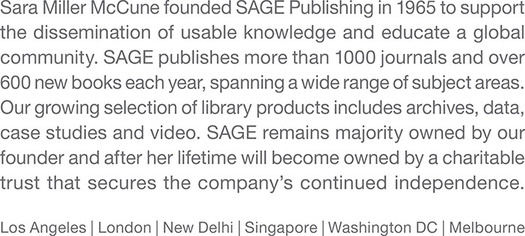FOR INFORMATION:
CQ Press
An imprint of SAGE Publications, Inc.
2455 Teller Road
Thousand Oaks, California 91320
E-mail: order@sagepub.com
SAGE Publications Ltd.
1 Olivers Yard
55 City Road
London EC1Y 1SP
United Kingdom
SAGE Publications India Pvt. Ltd.
B 1/I 1 Mohan Cooperative Industrial Area
Mathura Road, New Delhi 110 044
India
SAGE Publications Asia-Pacific Pte. Ltd.
18 Cross Street #10-10/11/12
China Square Central
Singapore 048423
Copyright 2020 by CQ Press, an imprint of SAGE. CQ Press is a registered trademark of Congressional Quarterly Inc.
All rights reserved. No part of this publication may be reproduced or transmitted in any form or by any means, electronic or mechanical, including photocopy, recording, or any information storage and retrieval system, without permission in writing from the publisher.
All third party trademarks referenced or depicted herein are included solely for the purpose of illustration and are the property of their respective owners. Reference to these trademarks in no way indicates any relationship with, or endorsement by, the trademark owner.
*SPSS is a registered trademark of International Business Machines Corporation.
Printed in the United States of America
Library of Congress Cataloging-in-Publication Data
Names: Pollock, Philip H., III, author.
Title: The essentials of political analysis / Phillip H. Pollock, III, University of Central Florida, Barry C. Edwards, University of Central Florida.
Description: Sixth Edition. | Washington, D.C. : CQ Press, A DIVISION OF SAGE, [2019] | Previous edition: 2016. | Includes bibliographical references and indexes.
Identifiers: LCCN 2019010373 | ISBN 9781506379616 (Paperback : alk. paper)
Subjects: LCSH: Political scienceResearchMethodologyTextbooks.
Classification: LCC JA86 .P65 2019 | DDC 320.072dc23 LC record available at https://lccn.loc.gov/2019010373
This book is printed on acid-free paper.
Typesetter: C&M Digitals (P) Ltd.
Preface
Students are of two minds about research methods. Many students can examine graphic or tabular data and offer a reasonably meaningful description of what they see. Provided with a set of procedural guidelines, students become competent at setting up cross-tabulations, comparing percentages or means, sketching bar charts, and writing a paragraph describing the data. At the same time, however, students balk at the idea that inferential statistics can serve as an interpretive tool. They tend to view statistical evidence as an odd element, an additional complication quite separate from their substantive findings.
This book cultivates students analytic abilities and develops their statistical reasoning. Consistent with prior editions, Chapters , which has been expanded for this edition, helps students conduct their own political analysis and write an effective research paper.
Because the practical application of methodological concepts enhances students comprehension, The Essentials of Political Analysis contains numerous hypothetical and actual examples. And because students become more adept at describing variables and interpreting relationships between them if they learn elemental graphing techniques, the chapters instruct in the interpretation of graphic displays of political variables. In addition to drawing on phenomena from U.S. politics, examples from comparative politics and international relations are also included. The narrative encourages students to stop and think about the examples, and the exercises at the end of each chapter permit students to apply their newly acquired skills.
Organization of the Book
The Essentials of Political Analysis is organized around a time-honored then reminds students of the ubiquity of conceptual questions in political sciencefor example, Are women more liberal than men?and asks them to consider how political researchers might address such questions. Following the discussion of the six objectives, the text summarizes the chapter and references each key term.
offers practical guidance on conducting original research and writing a research paper.
Abundant tables and figuresabout 100 in allillustrate methodological concepts and procedures. We use hypothetical data in some instances, but most of our examples are based on analyses of the American National Election Studies (ANES), the General Social Surveys (GSS), a dataset containing variables on a large number of countries, and data on the fifty U.S. states. Many of the end-of-chapter exercises ask students to analyze actual data as well. A solutions manual is available to instructors online. Video mini-lectures on chapter-specific content are available to students at edge.sagepub.com/pollock.

















